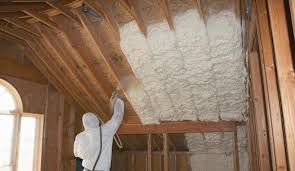The Key Differences between Open Cell and Closed Cell Foam Insulation
By Mark J. Donovan
|
|
Foam insulation is one of the best products for insulating a home. There are two major types, open cell and closed cell foam insulation. Open cell foam insulation is comprised of many tiny open cells with air gaps in between them. Closed cell foam insulation, on the other hand, is comprised of many tiny closed cells that are packed and fused together tightly. Each has their pros and cons, but with that said, closed cell foam insulation is the foam insulation of choice for many builders and homeowners. Besides providing a high R-value it also functions as a natural vapor barrier and does not require trimming.
Foam Insulation Density Closed cell spray foam insulation has a higher density than open cell foam insulation. |
Closed cell foam insulation has a density of around 2 lbs per square foot, whereas open cell foam insulation has a density of around only 0.5 lbs per square foot. Due to the higher density, closed cell foam insulation requires less space, and thus one of the key reasons why it is often chosen over open cell foam insulation.
| Open Cell versus Closed Cell Foam Insulation R-Values
In general, spray foam insulation provides one of the highest R-values of any type of home insulation product on the market. R-value is a measure of thermal resistance. Of the two foam insulation types, closed cell foam insulation provides the higher R-value. Closed cell foam insulation has an R-value of around 5.5 to 6.5, whereas open cell foam insulation has an R-value of approximately 3.5. The higher R-value per inch associated with closed cell foam insulation is another reason why it is often the foam insulation of choice. |
 |
Due to closed cell foam insulation’s higher density and R-Value, it requires less space than open cell foam insulation. Consequently it is ideal for narrow width wall and roof bay studding. Also, since closed cell foam insulation is a natural vapor barrier the installation of a separate vapor barrier is not required.
Close Cell Foam Insulation Requires No Trimming and is Less Messy
Another advantage of closed cell foam insulation, versus open cell foam insulation, is that it does not require trimming. Open cell foam insulation expands dramatically when sprayed into place. Consequently it expands out beyond the wall stud bays and needs to be trimmed flush with the wall studs before drywall paneling can be installed.
A cooler roof can translate into longer shingle life, and allowing water to exit the roof sheathing in the event of a leak will enable the roof to dry out and prevent mold and mildew growth.
For help on building a home addition, see HomeAdditionPlus.com’s Home Addition Bid Sheets. Our Home Addition Bid Sheets provide you with the knowledge and information on how to plan a home addition project, and what to look for when hiring contractors. They also include detailed cost breakdown tables and spreadsheets for estimating your own new home addition building costs.
Related Information
Free Home Addition Price Quotes with No Obligation!
Fill out our 3-5 minute quick and easy form, and receive a free price quote on a house addition from one of our prescreened and licensed home addition contractors. This process is free and there is no obligation to continue once you receive your house addition price estimate.

